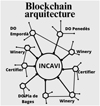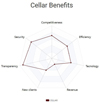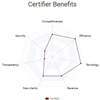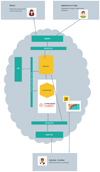| Issue |
BIO Web Conf.
Volume 68, 2023
44th World Congress of Vine and Wine
|
|
|---|---|---|
| Article Number | 03020 | |
| Number of page(s) | 6 | |
| Section | Law | |
| DOI | https://doi.org/10.1051/bioconf/20236803020 | |
| Published online | 23 November 2023 | |
Protecting the wine value chain through Blockchain
1 INCAVI, Institut Català de la Vinya i el Vi, Plaça Àgora, 2. 08720 Vilafranca del Penedès. Barcelona. España
2 Terra Alta Consultoria Tic, SL. C/Gaudí 3, bajos, 43786 Batea, Tarragona, España
3 INNOVI, Cluster Vitivinícola Català, Plaza Àgora, 1 08720 Vilafranca del Penedès
The project consists of the applicability of blockchain in the relationship between wineries and certifying entities, with the ultimate goal of their relationship with the competent authority. The project, named Localvino 2, has studied the capacity of blockchain to automate the certification of wine products based on the general regulations determined by the European Union and the particular ones of each denomination of origin (DO) included in their specifications. Specifically, the research has focused on wines from a qualified estate, wines with high added value and with the highest recognition granted by the official bodies of Catalonia, with the aim of extrapolating the results obtained to all the wines produced under the protection of the denominations of origin.
© The Authors, published by EDP Sciences, 2023
 This is an Open Access article distributed under the terms of the Creative Commons Attribution License 4.0, which permits unrestricted use, distribution, and reproduction in any medium, provided the original work is properly cited.
This is an Open Access article distributed under the terms of the Creative Commons Attribution License 4.0, which permits unrestricted use, distribution, and reproduction in any medium, provided the original work is properly cited.
1 Background
1.1 Protect the value of Catalan wines
One of the functions of the public administration is to ensure the quality and value of the services and products that the community, through the economic and social agents that make it up, produce and market. It is estimated that, globally, 20% of premium wine products suffer from some type of falsification or copy (1), which is detrimental to the original producers who take care of the value and authenticity of their products and to consumers, who pay for a product that is not actually the one offered. Catalonia is a country with a historic winemaking tradition. Where the vineyard and wine are elements that go beyond agricultural production. They are elements that have crossed the culture and identity of the country for more than 2,700 years and that weave unique communities with their own identities and singularities that share a story but at the same time all of them enjoy a unique idiosyncrasy.
The vineyard and wine are so relevant in Catalonia that INCAVI, through Law 2/2020, of March 5, on viticulture (2), reaffirmed a singular figure of special distinction to grant certain wines protection exclusive and specific: The wines from a qualified estate. These wines are characterized by complying with particularly restrictive production regulations that affect both the vineyard and their production, and which pursue excellence in their quality and typicity, becoming de facto ambassadors of Catalan wine culture and quality. They are the maximum expression of the different forms of Catalan terroir.
In Catalonia there are 12 wine denominations of origin, which cover a total of more than 750 producing wineries, with a turnover of 1,400 MEUR. These are wineries of various sizes (from small family projects to large corporations), which produce 350 million bottles per year. Catalonia exports 65% of the sparkling wine and 45% of the still wine it produces to the world. All of this, at the same time, is possible thanks to the efforts of 8,500 viticulturists, who cultivate 57,000 hectares of vineyards (3) from North to South of the country, and who are a fundamental piece in the territorial balance and in the fight against depopulation.
With regard to product certification, there are, in relation to still wine, 2 certification entities accredited by the National Accreditation Entity (ENAC). As a corollary to the context of the factual relationship exposed, INCAVI, together with the AEI INNOVI cluster, the AEI Clúster Aragonés de Alimentación, the Penedès Denomination of Origin, the Abadal winery, and the company Terra Alta Consultoría TIC, SL –TACTIC, with the financial support of the Ministry of Industry, Commerce and Tourism the financing of the project through the support program for Innovative Business Groups (AEI), decides to substantiate a project, called Localvino 2 (4), which allows the conceptual and practical study of the audit of wines from a qualified estate, as a realistic test of what the application of blockchain technology can be in the audit process, valuing its advantages and disadvantages.
Protecting the value of wines also means working for the sustainability of the sector, both at an economic, social, cultural and environmental level. It means, then, giving tools to the sector so that it can strengthen its products in international markets through the guarantee and continuous improvement of quality.
1.2 Digitalisation and democratization strategy
The application of new technologies to the winery audit process is the result of a general reflection that leads INCAVI, within the framework of its Strategic Plan #Horizonte2025 (5) and specifically with the project called “Promoting INCAVI's activity as competent authority”, to the determination that it is necessary to reduce bureaucratization of the audit work, with clear and defined objectives:
- –
Lighten the audit process that wineries must undergo, at least once a year,
- –
Strengthen the traceability of the final product,
- –
Increase the notoriety of the wine as a perception of territoriality and quality in the appreciation of the final consumer,
- –
Minimize the dedication of human and material resources by the winery and the certification entity,
- –
Allow a verification of the production and processing parameters included in the specifications,
- –
The protection of the wine value chain in its entirety.
This specific digitalisation strategy in the field of wine traceability is a concretion of INCAVI's general strategy, which aims to promote comprehensive digitalisation of the sector, following strategies in smart vineyards and smart cellars.
Likewise, this strategy coincides with axes 2 and 5 of the OIV Strategic Plan (6), when it determines them in “Promoting an economic activity based on the principles of sustainable development and growth and globalization of markets” and “Favoring the digital transition in industry”.
1.3 Towards digital leadership
Traceability has become a useful and necessary tool to ensure the correct functioning and knowledge of the wine production, elaboration and commercialization process. Traceability in viticulture is key, since it is the first point of control of the entire production chain of the wine sector.
Traceability constantly improves the quality of production, gives security to the consumer and increases the competitiveness of the product. Food safety and the supply of healthy agro-food products are one of the main concerns for consumers, and taking into account that information systems favor trust and transparency in processes, the wine market is no stranger to this reality. For this reason, traceability has become a useful and necessary tool to ensure proper functioning and knowledge of the wine production, elaboration and marketing process.
The wine sector is part of the food industry, and as such must guarantee food traceability processes. This sector, in a special and intensive way, also enjoys the DOP/PGI food quality seals regulated by the European regulations established in Regulation (EU) no. 1308/2013 of the European Parliament and of the Council, of December 17, 2013, which creates the common organization of markets for agricultural products and which repeals Regulations (EEC) no. 922/72, (EEC) no. 234/79, (EC) no. 1037/2001 and (EC) no. 1234/2007 (7).
There are, apart from those mentioned, other regulations that affect the sector, and consequently generate a significant administrative burden, and therefore, a commitment to digitalisation is necessary, with the aim of generating value continuously and distributed in all links. of the chain. Digitalisation in the wine sector simplifies regulatory and administrative processes through the automation and integration of computer systems. Digitalisation is therefore a key element in traceability and increases the competitiveness of the different agents in the value chain, improving their efficiency in the different production and administrative processes.
The Catalan wine sector enjoys very good “digital health”, with very high levels of innovation and research, which are the result of a very relevant digital maturity, which at the same time give rise to remarkable levels of digital and technological implementation, despite Being a production area closely linked to the primary sector and traditionally not very digitized. There are many initiatives that allow us to verify that there are digitalisation solutions for the entire value chain, therefore, this important element allows us to face a project of this dimension with guarantees.
The key idea of this whole process is to make the processes more efficient, reducing bureaucratic auditing and simplifying the tasks for the wineries. The ultimate objective is to have the data related to traceability without the need for them to be provided by the wineries, but rather that they are already accessible at the time of the audit.
This project has been able to be carried out thanks to the close collaboration of the working group, of public-private composition, in all its phases. A heterogeneous working group, which has involved the actors who directly participate in all the steps identified in the production and certification of wine products, and which has allowed us to have a broad and detailed vision of the processes involved.
The project has made it possible to identify the synergies that occur in each step of the global production and certification process, and thus, determine the key and control points that must be established in the application of blockchain technology to the wine sector.
Thanks to this project, it has been possible to implement a real application of the case in a specific geographical context, conditioned by specific regulations thanks to the strategic vision provided by INCAVI. On the other hand, it has been possible to reproduce the real traceability of the wines from a qualified estate produced by the Abadal winery, with the administrative and procedural supervision defined by the Penedès Denomination of Origin, and thanks to the technology provided by Terra Alta Consultoría TIC, specialists technologies in wine traceability solutions.
 |
Figure 1. Wine production and certification workflow. |
2 Materials and methods
2.1 Application and use of blockchain technology to the wine sector
To carry out the project, the analysis of different real scenarios of traceability management and subsequent certification audit has been carried out. Through the established conclusions, it has been decided to opt for a strategy of copying certain data on the blockchain platform. This makes it possible for the auditor to verify the information on the blockchain and compare this information with the records of the wineries and regulatory councils.
Therefore, a second layer of homogeneous traceability has been generated in the blockchain platform that is updated as the actors record the information in their systems. The system is selective and records essential information on the blockchain in the agreed time and manner.
At the same time as determining the blockchain technology, the different options that currently exist in the market and the applicability that each of them offers in this use case have been analyzed.
2.2 Blockchain: Disruptive technology 4.0 as a traceability solution
Focusing on Blockchain technology, in recent years, it has been considered one of the technologies that can change the way many sectors and industrial processes operate. The use of this technology promotes the generation of new business models that will allow the industrial sector to accelerate towards the transition of Industry 4.0.
Already in 2019, the Gartner Hype cycle (8) for emerging technologies identified blockchain as one of the technologies that will lead to the comprehensive reform of industries, having its revolutionary development over the next five years (Fig. 2).
Considering the different categories of solutions or functionalities offered by blockchain technology, it is considered that the Localvino phase 2 project is located in the “Slope of Enlightenment” area, which is a step prior to the productivity plateau, in which organizations begin to adopt technology to improve their competitiveness. The blockchain capacity to respond to real, useful and specific cases is being identified and validated.
Blockchain technology offers a series of features that perfectly fit the needs identified in this project, when applied properly (Fig. 3).
Distribution. The participants, connected in a distributed network, operate nodes (computers) that run a program to enforce the business rules of the blockchain. The nodes also maintain a complete copy of the ledger, which is independently updated when new transactions occur.
Encryption. Blockchain uses technologies such as public and private keys to record data in a secure and semi-anonymous way. During the process of creating a Bitcoin wallet, for example, the blockchain generates an address for the participant that is visible to all network participants, but provides a pseudonym.
Immutability. Completed transactions are cryptographically signed, time-stamped, and sequentially added to the ledger. Records cannot be changed unless all participants agree to do so. Such an agreement is known as a bifurcation.
Decentralization. No single entity controls most of the nodes or dictates the rules. A consensus mechanism verifies and approves transactions, eliminating the need for a central intermediary to govern the network. Decentralization, and its inverse, centralization, comprises three core elements: technology, economics, and decision-making. Each can be adjusted to vary the way governance is applied to the ecosystem.
Therefore, it is considered that this technology provides the necessary tools to face the challenge of unifying the different agents involved in the wine production value chain on a single platform. From the production of the grapes by the winegrowers to the audits of origin and quality carried out by independent certifying entities, going through the wine-making wineries and the denominations of origin that ensure correct compliance with the legal requirements established by the particular regulations, and finally, by the competent authority, exercised in Catalonia by the INCAVI, which ensures the correct overall functioning of all the processes.
This platform allows the generation of a trust environment that makes it possible to interconnect the actions carried out by each actor and facilitates, through the automation and interconnection of processes, the communication between them and the subsequent verification by independent auditors and, ultimately, provides the consumer with all the relevant information for secure traceability.
 |
Figure 2. Gartner's Hype Cycle for Blockchain 2021. |
 |
Figure 3. Proposed blockchain network. |
 |
Figure 4. Estimated producer benefits. |
 |
Figure 5. Estimated certifier benefits. |
2.3 Methodology and validation of data from official records: RVC and cellar book
The method currently used prescribes an assessment and validation of settlements made by the winery itself in vineyrad records, in this case the Catalan Vineyard Register (RVC), and in the winery books themselves.
For the validation of the settlements, a face-to-face visit by the auditor is required, a prior compilation of the documentation by the audited operator to make them available, and a final assessment by the auditor that compares the information available against the prescriptions contained in the specifications. of the denomination of origin that pairs the wine produced.
With the application of the new system, the operator will record the data related to the wine production and elaboration process through blockchain technology, and the auditor will be able to access them at the time of the audit.
3 Results and Discussion
In this project, it has been possible to validate the capacity of the technology to respond to the problems raised, so that the traceability of the wines from a qualified estate has been registered on the blockchain platform, therefore, it is clear that the generation of records by part of the Abadal winery and the Penedès appellation of origin on the blockchain make it possible to guarantee and reproduce the traceability of the wines. The key processes of making a wine from a qualified estate have been analyzed and identified and the data that specifically affects the elements reviewed by the certification entities have been recorded on the blockchain. These are:
The entry of the grapes into the winery with the registration of the corresponding plot.
The yield of grape press extraction.
The oenological practices involved in the production process.
Wine aging processes.
Records of losses that occur during the winemaking process.
Packaging and storage processes.
Qualification processes by the appellation of origin.
The processes of labeling and launching the product on the market.
Blockchain technology has made it possible to verify that the registered data is inviolable, and that it allows checking the dates on which they have been registered. The data referred to appears in the Catalan Vineyard Register (RVC), as well as in the winery books of each operator.
As of January 15, 2022, winegrowers have already been able to carry out procedures directly in the evolution of the RVC, called e-RVC, and as of August 1, 2023 it will be used, in the same way that it had been done with the previous version, to control the entry of grapes into the wineries and reinforcing traceability, transparency and access to data electronically.
This is a key element to be able to give conformity to the product audit, so that the certifying entity can know the timing of the different processes and therefore the correct compliance with the regulations regarding the verification of the correct annotation in the records. in the legally established periods.
As it is a distributed platform, all the actors that participate in traceability access the information remotely through a digital interface, therefore, the capacity of the technology to offer an improvement in the verification of the information would also be validated, allowing the certifying entity to carry out more checks with fewer resources by being able to eliminate physical movements to the wine production and packaging centers. This is possible thanks to the reliability offered by blockchain technology.
Through this project, thanks to the analysis carried out on the state of digitalisation of the wineries, it has been possible to verify the interoperability of this technology. The generated platform has allowed the project to be carried out without any actor having to carry out any task differently from what is currently carried out, therefore, the administrative burden of the actors has not increased. This is an essential element when proposing a global, scalable and transparent solution.
The independence required by the different actors remains intact, and allows them to connect to the platform as they adopt the technology in their systems. This makes it possible to guarantee equity and the democratization of technology for all types and sizes of actors, regardless of their work system and technological capacity.
 |
Figure 6. Software components diagram. |
4 Conclusions
The proposed solution is based on a private network, with limited access to project members, permissioned, generated and managed by a self-erected IT manager, and the reasons have been the following:
low costs. It does not have to be paid per transaction, but requires technical maintenance (platform and hosting).
scalability. It allows adding nodes as the network grows.
permissioned (it is known what each one does). It allows to identify the wineries and DO that intervene in the traceability process.
privacy. Actors outside the network cannot access the information.
Centralized management. In charge of a reliable organization (INCAVI and DO).
In this project we have also been able to identify the challenges to face in a hypothetical global implementation throughout the Catalan wine sector, with the aim of implementing a useful and effective tool that allows optimizing and automating all the processes involved in the value chain, going through the search for alliances with processing agents in order to facilitate the implementation of the solution and scale it to the rest of the wines of the wineries. The final claim is to improve the competitiveness of the operators involved, protect value and guarantee a prosperous and stimulating future.
References
- S. Schier. https://forkast.news/how-nfts-blockchain-can-end-wine-fraud/ [Google Scholar]
- Diario Oficial de la Generalitat de Catalunya, número 8080, de 9 de marzo de 2020 https://dogc.gencat.cat/es/document-del-dogc/?documentId=869802 [Google Scholar]
- Catalan Wines website. https://catalanwines.com/es/ [Google Scholar]
- Localvino 2 Project: Implementation of IoT and Blockchain certification by appellations of origin for fraud prevention (Phase 2) [Google Scholar]
- Incavi website. https://incavi.gencat.cat/ca/inici/ [Google Scholar]
- OIV website. https://www.oiv.int/es [Google Scholar]
- Official Journal of the European Union L 347 de 20.12.2013) https://eur-lex.europa.eu/legal-content/EN/TXT/?uri=OJ:L:2013:347:TOC&toc=OJ:L:2019:184:FULL [Google Scholar]
- A. Litan https://blogs.gartner.com/avivah-litan/2021/07/14/hype-cycle-for-blockchain-2021-more-action-than-hype/ [Google Scholar]
All Figures
 |
Figure 1. Wine production and certification workflow. |
| In the text | |
 |
Figure 2. Gartner's Hype Cycle for Blockchain 2021. |
| In the text | |
 |
Figure 3. Proposed blockchain network. |
| In the text | |
 |
Figure 4. Estimated producer benefits. |
| In the text | |
 |
Figure 5. Estimated certifier benefits. |
| In the text | |
 |
Figure 6. Software components diagram. |
| In the text | |
Current usage metrics show cumulative count of Article Views (full-text article views including HTML views, PDF and ePub downloads, according to the available data) and Abstracts Views on Vision4Press platform.
Data correspond to usage on the plateform after 2015. The current usage metrics is available 48-96 hours after online publication and is updated daily on week days.
Initial download of the metrics may take a while.



